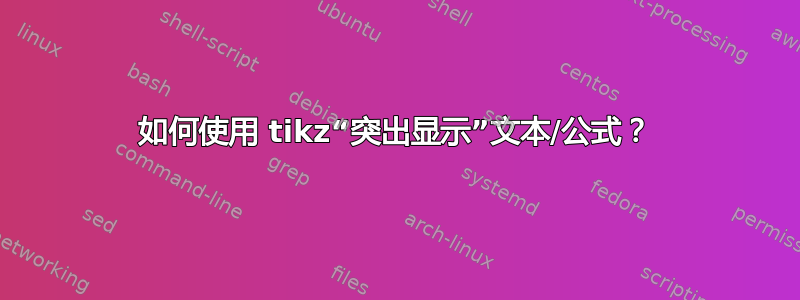
我尝试构造一个黄色矩形(带有tikz),以便我可以使用它来“突出显示”一段文本。下面是一个最小示例。它已经看起来不错了,但我如何避免单词“dummy”被凸起?所有单词都应位于同一高度。
\documentclass{scrartcl}
\usepackage[T1]{fontenc}
\usepackage[american,ngerman]{babel}
\usepackage{tikz}
\newcommand*{\yellowemph}[1]{%
\tikz\node[rectangle, fill=yellow, rounded corners, inner sep=0.3mm]{#1};%
}
\begin{document}
Just some \yellowemph{dummy} text to see what happens.
\end{document}
更新
谢谢大家的帮助。下面,我简要概述/比较了建议的方法。不幸的是,版本 3 和 4 覆盖了文本。版本 2(灵魂)不起作用之内数学模式(甚至不能通过将其包装在 中\text{})。我喜欢版本 1。请参阅此页面以了解如何自动确定是否处于数学模式:\newcommand:如何确定是否处于数学模式(然后包括$ $)?
\documentclass{article}
\usepackage[T1]{fontenc}
\usepackage[american,ngerman]{babel}
\usepackage{tikz}
%%%%%%%%%%%%%%%%%%%%%%%%%%%%%%%%%%%%%%%%%%%%%%%%%%%%%%%%%%%%%%%%%%%%%%%%%%%%%%%%
% version 1: needs $ $ in math mode; not work across line boundaries
\newcommand*{\yellowemph}[1]{%
\tikz[baseline=(text.base)]\node(text)[rectangle, fill=yellow, rounded
corners, inner sep=0.3mm]{#1};%
}
% version 2: does not seem to work in math mode, not even with $ $
\usepackage{soul}% use \hl{} to highlight
% version 3: does not work across line boundaries
% see https://tex.stackexchange.com/questions/35319/a-boxed-alternative-with-minimal-spacing/35357#35357
\usetikzlibrary{calc, shapes}
\makeatletter
\newcommand*{\@DrawBoxHeightSep}{0.030em}%
\newcommand*{\@DrawBoxDepthSep}{0.025em}%
\newcommand{\@DrawBox}[3][red]{% #1=style, #2=height, #3=depth
\tikz[overlay,remember picture]{
\draw[#1]
($(bl)+(-0.2em,#2+\@DrawBoxHeightSep)$) rectangle
($(br)+(0.2em,-#3-+\@DrawBoxDepthSep)$);}
}
\newcommand{\tikzmark}[1]{\tikz[overlay,remember picture] \node (#1) {};}
\newdimen\@myBoxHeight%
\newdimen\@myBoxDepth%
\newcommand{\MyBox}[2][red]{%
\settoheight{\@myBoxHeight}{#2}% record height of box
\settodepth{\@myBoxDepth}{#2}% record height of box
\tikzmark{bl}#2\tikzmark{br}\@DrawBox[#1]{\@myBoxHeight}{\@myBoxDepth}% draw the box
}
\makeatother
% version 4: text gets overwritten
% see
% https://tex.stackexchange.com/questions/5959/cool-text-highlighting-in-latex
% \usepackage{soul}
% \usepackage{tikz}
% \usetikzlibrary{calc}
\usetikzlibrary{decorations.pathmorphing}
\makeatletter
\newcommand{\defhighlighter}[3][]{%
\tikzset{every highlighter/.style={color=#2, fill opacity=#3, #1}}%
}
\defhighlighter{yellow}{.5}
\newcommand{\highlight@DoHighlight}{
\fill [ decoration = {random steps, amplitude=1pt, segment length=15pt}
, outer sep = -15pt, inner sep = 0pt, decorate
, every highlighter, this highlighter ]
($(begin highlight)+(0,8pt)$) rectangle ($(end highlight)+(0,-3pt)$) ;
}
\newcommand{\highlight@BeginHighlight}{
\coordinate (begin highlight) at (0,0) ;
}
\newcommand{\highlight@EndHighlight}{
\coordinate (end highlight) at (0,0) ;
}
\newdimen\highlight@previous
\newdimen\highlight@current
\DeclareRobustCommand*\highlight[1][]{%
\tikzset{this highlighter/.style={#1}}%
\SOUL@setup
%
\def\SOUL@preamble{%
\begin{tikzpicture}[overlay, remember picture]
\highlight@BeginHighlight
\highlight@EndHighlight
\end{tikzpicture}%
}%
%
\def\SOUL@postamble{%
\begin{tikzpicture}[overlay, remember picture]
\highlight@EndHighlight
\highlight@DoHighlight
\end{tikzpicture}%
}%
%
\def\SOUL@everyhyphen{%
\discretionary{%
\SOUL@setkern\SOUL@hyphkern
\SOUL@sethyphenchar
\tikz[overlay, remember picture] \highlight@EndHighlight ;%
}{%
}{%
\SOUL@setkern\SOUL@charkern
}%
}%
%
\def\SOUL@everyexhyphen##1{%
\SOUL@setkern\SOUL@hyphkern
\hbox{##1}%
\discretionary{%
\tikz[overlay, remember picture] \highlight@EndHighlight ;%
}{%
}{%
\SOUL@setkern\SOUL@charkern
}%
}%
%
\def\SOUL@everysyllable{%
\begin{tikzpicture}[overlay, remember picture]
\path let \p0 = (begin highlight), \p1 = (0,0) in \pgfextra
\global\highlight@previous=\y0
\global\highlight@current =\y1
\endpgfextra (0,0) ;
\ifdim\highlight@current < \highlight@previous
\highlight@DoHighlight
\highlight@BeginHighlight
\fi
\end{tikzpicture}%
\the\SOUL@syllable
\tikz[overlay, remember picture] \highlight@EndHighlight ;%
}%
\SOUL@
}
\makeatother
%%%%%%%%%%%%%%%%%%%%%%%%%%%%%%%%%%%%%%%%%%%%%%%%%%%%%%%%%%%%%%%%%%%%%%%%%%%%%%%%
\begin{document}
\noindent
word $\frac{1}{2}$ $\displaystyle\frac{1}{2}$\\
\yellowemph{word} \yellowemph{$\frac{1}{2}$}
\yellowemph{$\displaystyle\frac{1}{2}$} $\yellowemph{$\displaystyle\frac{1}{2}$}$; Version 1: does not work across lines\\
\hl{word} \hl{$\frac{1}{2}$} \hl{$\displaystyle\frac{1}{2}$}
%$\text{\hl{$\displaystyle\frac{1}{2}$}}$
; Version 2: soul, does not work \emph{within} math mode!\\
\MyBox[fill=yellow, draw=yellow, opacity=0.3]{word} \MyBox[fill=yellow,
draw=yellow, opacity=0.3]{$\frac{1}{2}$} \MyBox[fill=yellow, draw=yellow,
opacity=0.3]{$\displaystyle\frac{1}{2}$}
%$\MyBox[fill=yellow, draw=yellow, opacity=0.3]{$\displaystyle\frac{1}{2}$}$
; Version 3: overwrites text; does not work \emph{within} math mode or across lines\\
\highlight{word} \highlight{$\frac{1}{2}$}
\highlight{$\displaystyle\frac{1}{2}$} $\highlight{$\displaystyle\frac{1}{2}$}$;
Version 4: overwrites text
\end{document}
答案1
您可以为节点命名并将其与该基线对齐:

笔记:
- 这仅适用于不跨越行边界的小段文本。如果您需要它跨越行边界,您应该考虑包裹
soul。一个很好的例子可以在这里找到LaTeX 中的酷炫文本突出显示。 - 正如@percusse所建议的,你还应该考虑包裹
mdframed如果您有兴趣突出显示整个段落。
代码:
\documentclass{scrartcl}
\usepackage[T1]{fontenc}
\usepackage[american,ngerman]{babel}
\usepackage{tikz}
\newcommand*{\yellowemph}[1]{%
\tikz[baseline=(X.base)] \node[rectangle, fill=yellow, rounded corners, inner sep=0.3mm] (X) {#1};%
}
\begin{document}
Just some \yellowemph{dummy} text to see what happens.
\end{document}
答案2
像彼得的回答一样,但没有为节点添加新名称
\documentclass{scrartcl}
\usepackage[T1]{fontenc}
\usepackage[american,ngerman]{babel}
\usepackage{tikz}
\newcommand*{\yellowemph}[1]{%
\tikz[baseline]\node[rectangle, fill=yellow, rounded corners, inner sep=0.3mm,anchor=base]{#1};%
}
\begin{document}
Just some \yellowemph{dummy} text to see what happens.
\end{document}

答案3
这是我目前为此使用的代码。我主要用它突出显示(或淡化)演示文稿的短片段,因此它不适合处理长片段(尽管它可以合理地尝试),并且几乎肯定会因分页符而出错。它的主要缺点是它不会自动调整到文本的大小,因为它不能通过将文本放在框中来工作。相反,它会在文本下方(突出显示,淡化)绘制突出显示。因此,您应该更多地将其视为使用荧光笔突出显示文本,而不是绘制框并填充它。当然,您可以使用更粗的笔,并且有按键来自定义这些内容。
有三种变体:荧光笔、渐变笔和垂直荧光笔。每种笔的工作原理都是标记要标记的部分的开始和结束。然后 TikZ 会从开始到结束绘制荧光笔颜色的粗线。如果位移允许,线条会换行(垂直荧光笔的情况是垂直的)。荧光笔和推子是绘制线条的时间。对于荧光笔,线条从起始位置发出,有效地将它们放置在文本下方。对于渐变器,线条从结束位置发出,将它们放置在文本上方。
以下是一个示例:

这是代码。我尝试让它在 Beamer 和非 Beamer 上工作。在 Beamer 中,你可以做类似的事情\highlight<2>{only on slide 2}。有两种方法可以调用突出显示。一种是说\highlight{text to be highlighted}另一种是说\hlstart text to be highlighted \hlend。有时后者会提供更多的灵活性(上面的垂直突出显示就是以这种方式完成的)。
这是代码。该amsmath包仅适用于bmatrix环境。上面的示例实际上是使用beamer(并取消注释frame环境)生成的。
\documentclass{article}
%\url{http://tex.stackexchange.com/q/46434/86}
\usepackage{amsmath}
\usepackage{tikz}
\makeatletter
%
% Highlighter code
%
\tikzset{%
remember picture with id/.style={%
remember picture,
overlay,
save picture id=#1,
},
save picture id/.code={%
\edef\pgf@temp{#1}%
\immediate\write\pgfutil@auxout{%
\noexpand\savepointas{\pgf@temp}{\pgfpictureid}}%
}
}
\def\savepointas#1#2{%
\expandafter\gdef\csname save@pt@#1\endcsname{#2}%
}
\tikzdeclarecoordinatesystem{pic}{%
\@ifundefined{save@pt@#1}{%
\pgfpointorigin
}{%
\pgfsys@getposition{\csname save@pt@#1\endcsname}\save@orig@pic%
\pgfsys@getposition{\pgfpictureid}\save@this@pic%
\pgf@process{\pgfpointorigin\save@this@pic}%
\pgf@xa=\pgf@x
\pgf@ya=\pgf@y
\pgf@process{\pgfpointorigin\save@orig@pic}%
\advance\pgf@x by -\pgf@xa
\advance\pgf@y by -\pgf@ya
}%
}
\newcounter{highlight}
\newcommand{\hlstart}{\tikz[remember picture with id=hlstart\the\value{highlight},baseline=-0.7ex];\hl@start}
\newcommand{\hlend}{\tikz[remember picture with id=hlend\the\value{highlight},baseline=-0.7ex];\hl@end\stepcounter{highlight}}
\newcommand{\fdstart}{\tikz[remember picture with id=hlstart\the\value{highlight},baseline=-0.7ex];\fd@start}
\newcommand{\fdend}{\tikz[remember picture with id=hlend\the\value{highlight},baseline=-0.7ex];\fd@end\stepcounter{highlight}}
\newcommand{\vlstart}{\tikz[remember picture with id=hlstart\the\value{highlight},baseline=-1em];\vl@start}
\newcommand{\vlend}{\tikz[remember picture with id=hlend\the\value{highlight},baseline=0.3ex];\vl@end\stepcounter{highlight}}
\newcommand{\hl@start}[1][]{%
\hl@draw{highlighter}{#1}{\the\value{highlight}}}
\newcommand{\hl@end}{}
\newcommand{\fd@start}[1][]{%
\def\fd@args{#1}}
\newcommand{\fd@end}{\def\@tempa{\hl@draw{fader}}\expandafter\@tempa\expandafter{\fd@args}{\the\value{highlight}}\def\fd@args{}}
\newcommand{\vl@start}[1][]{%
\vl@draw{highlighter}{#1}{\the\value{highlight}}}
\newcommand{\vl@end}{}
\def\hl@sets{%
\edef\hl@sx{\the\pgf@x}%
\edef\hl@sy{\the\pgf@y}%
}
\def\hl@sete{%
\edef\hl@ex{\the\pgf@x}%
\edef\hl@ey{\the\pgf@y}%
}
\@ifclassloaded{beamer}{
\def\page@node{
\path (current page.south east)
++(-\beamer@rightmargin,\footheight)
node[
minimum width=\textwidth,
minimum height=\textheight,
anchor=south east
] (page) {};
}
}{
\def\page@node{
\path (current page.north west)
++(\hoffset + 1in + \oddsidemargin + \leftskip,\voffset + 1in + \topmargin + \headheight + \headsep)
node[
minimum width=\textwidth - \leftskip - \rightskip,
minimum height=\textheight,
anchor=north west
] (page) {};
}
}
\newcommand{\hl@draw}[3]{%
\begin{tikzpicture}[remember picture,overlay]%
\page@node
\tikzset{#2,highlight=#1,every path/.append style={highlight=#1}}%
\pgfmathsetlengthmacro{\hl@width}{\the\pgflinewidth - 1pt}%
\coordinate (hlstart) at (pic cs:hlstart#3);
\coordinate (hlend) at (pic cs:hlend#3);
\tikz@scan@one@point\hl@sets(pic cs:hlstart#3)
\tikz@scan@one@point\hl@sete(pic cs:hlend#3)
\ifdim\hl@sy=\hl@ey\relax
\draw (hlstart) -- (hlend);
\else
\draw (hlstart) -- (hlstart -| page.east);
\pgfmathsetlengthmacro{\hl@sy}{\hl@sy -\hl@width}%
\pgfmathsetlengthmacro{\hl@ey}{\hl@ey +\hl@width}%
\loop\ifdim\hl@sy>\hl@ey\relax
\draw (0,\hl@sy -| page.west) -- (0,\hl@sy -| page.east);
\pgfmathsetlengthmacro{\hl@sy}{\hl@sy -\hl@width}%
\repeat
\draw (hlend -| page.west) -- (hlend);
\fi
\end{tikzpicture}%
}
\newcommand{\vl@draw}[3]{%
\begin{tikzpicture}[remember picture,overlay]%
\page@node
\tikzset{#2,highlight=#1,every path/.append style={highlight=#1}}%
\pgfmathsetlengthmacro{\hl@width}{\the\pgflinewidth - 1pt}%
\coordinate (hlstart) at (pic cs:hlstart#3);
\coordinate (hlend) at (pic cs:hlend#3);
\tikz@scan@one@point\hl@sets(pic cs:hlstart#3)
\tikz@scan@one@point\hl@sete(pic cs:hlend#3)
\ifdim\hl@sx=\hl@ex\relax
\draw (hlstart) -- (hlend);
\else
\draw (hlstart) -- (hlstart |- page.south);
\pgfmathsetlengthmacro{\hl@sx}{\hl@sx -\hl@width}%
\pgfmathsetlengthmacro{\hl@ex}{\hl@ex +\hl@width}%
\loop\ifdim\hl@sx>\hl@ex\relax
\draw (\hl@sx,0 |- page.north) -- (\hl@sx,0 |- page.south);
\pgfmathsetlengthmacro{\hl@sx}{\hl@sx -\hl@width}%
\repeat
\draw (hlend |- page.north) -- (hlend);
\fi
\end{tikzpicture}%
}
\tikzset{%
highlight/.default=highlighter,
highlight/.style={
color=\pgfkeysvalueof{/tikz/#1 colour},
line width=\pgfkeysvalueof{/tikz/#1 width},
line cap=\pgfkeysvalueof{/tikz/#1 cap},
opacity=\pgfkeysvalueof{/tikz/#1 opacity},
},
highlighter colour/.initial=yellow,
highlighter width/.initial=12pt,
highlighter cap/.initial=butt,
highlighter opacity/.initial=1,
fader colour/.initial=gray,
fader width/.initial=12pt,
fader cap/.initial=butt,
fader opacity/.initial=.5,
}
\@ifclassloaded{beamer}{
%% Beamer variants
\setbeamercolor{highlighted text}{bg=yellow}
\setbeamercolor{faded text}{fg=gray}
\newcommand<>{\highlight}[2][]{%
\only#3{\hlstart[#1]}#2\only#3{\hlend}}
\newcommand<>{\fade}[2][]{%
\only#3{\fdstart[#1]}#2\only#3{\fdend}}
\newcommand<>{\vhighlight}[2][]{%
\only#3{\vlstart[#1]}#2\only#3{\vlend}}
}{
\newcommand{\highlight}[2][]{%
\hlstart[#1]#2\hlend}
\newcommand{\fade}[2][]{%
\fdstart[#1]#2\fdend}
\newcommand{\vhighlight}[2][]{%
\vlstart[#1]#2\vlend}
}
\makeatother
\begin{document}
%\begin{frame}
This is some \highlight{highlighted} text. With displaystyle maths, we might have to adjust the line width to get \highlight[highlighter width=24pt]{\(\displaystyle \frac12\)}.
\highlight[highlighter cap=round]{For a very long line, we get basic line wrapping. It's a little creaky around the edges so may not be as robust as it could be.}
Sometimes, though, one wants to \fade[fader colour=white]{fade} some text.
Vertical highlighting is useful in matrices:
%
\[
\begin{bmatrix}
1 & \vlstart 2 & 3 \\
4 & \vlend 5 & 6
\end{bmatrix}
\]
%\end{frame}
\end{document}


